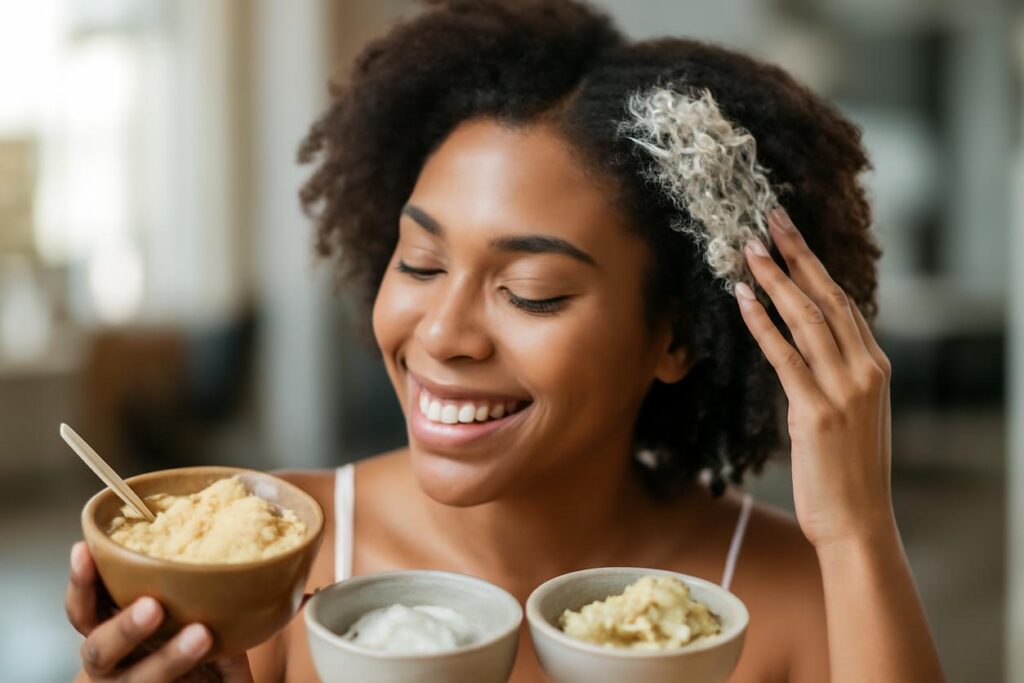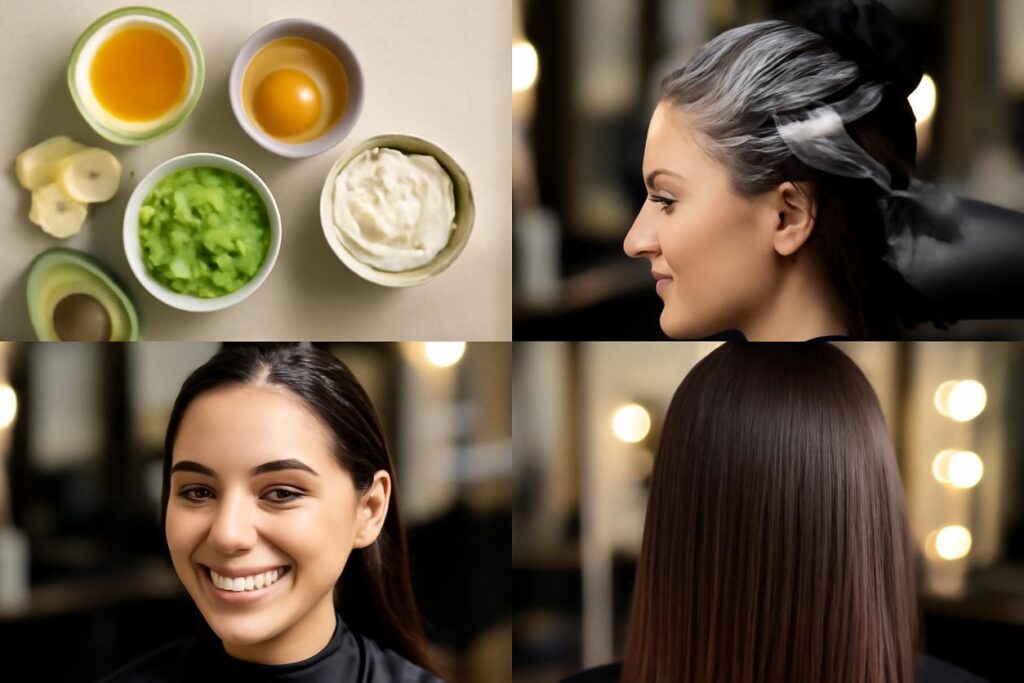Why a DIY Hair Mask is Your Secret Weapon for Healthy Hair
Welcome to the world of personalized hair care, straight from your kitchen. If you’ve ever looked at your hair and wished for more shine, less frizz, or deeper hydration, the answer might not be on a store shelf. A DIY hair mask is a powerful, cost-effective, and natural way to give your hair precisely what it needs. Unlike many commercial products, a homemade hair mask puts you in complete control. You know every single ingredient, you can tailor recipes to your exact hair concerns, and you avoid unnecessary silicones, parabens, and sulfates.
The core principle is simple: fresh, whole ingredients are packed with the vitamins, fats, and proteins that form the building blocks of healthy hair. By applying these nutrients directly, you provide a concentrated treatment that can moisturize, strengthen, and protect your strands from the inside out. This guide will walk you through everything you need to know to become a master of the DIY hair mask, transforming your hair care routine for 2025 and beyond.
Quick Assessment: Choose the Right DIY Hair Mask for Your Hair Type
Before you start mixing, it’s crucial to understand what your hair is asking for. A DIY hair mask that works wonders for dry, thick hair might weigh down fine, oily hair. Use this quick guide to identify your hair’s primary need.
- Fine or Oily Hair: Your hair gets greasy quickly and can feel weighed down by heavy products. You need lightweight hydration and clarifying ingredients. Avoid heavy oils like olive or coconut oil directly on the scalp.
- Dry or Frizzy Hair: Your hair lacks moisture, may feel rough, and is prone to frizz. You need intense moisture and hydration. Look for ingredients rich in healthy fats and humectants (which attract moisture).
- Damaged or Brittle Hair: Your hair may be over-processed from coloring, heat styling, or environmental factors. It breaks easily. You need protein and deep conditioning to repair and strengthen the hair cuticle.
- Dull Hair: Your hair lacks shine and vibrancy. You need ingredients that can smooth the hair cuticle and provide a vitamin boost for a natural gloss.
- Itchy or Flaky Scalp: The problem starts at the root. You need a soothing and balancing scalp treatment to create a healthy environment for hair growth.
Once you’ve identified your main concern, you can select recipes and ingredients specifically designed to address it, making your DIY hair mask truly effective.
Kitchen Powerhouses: Key Ingredients for Your Homemade Hair Mask and What They Do
The magic of a DIY hair mask lies in its ingredients. Understanding the “why” behind each component will help you customize recipes with confidence. Here’s a breakdown of common kitchen staples and their hair-loving nutrients.
| Ingredient | Key Nutrients and Benefits | Best For |
|---|---|---|
| Avocado | Rich in oleic acid, monounsaturated fats, and vitamins A, D, and E. Deeply moisturizes, nourishes, and strengthens the hair shaft. | Dry, Damaged, Frizzy Hair |
| Yogurt (Plain, Full-Fat) | Contains lactic acid to cleanse the scalp and protein to strengthen hair. Probiotics can help balance the scalp’s microbiome. | Fine, Oily, Dull Hair |
| Honey (Raw) | A natural humectant, it draws moisture into the hair. Its antibacterial properties are also great for scalp health. | Dry, Dull, Flaky Scalp |
| Egg | The yolk is rich in fats and vitamins for moisture, while the white is packed with protein to fortify strands. Use the whole egg for balance. | Damaged, Brittle, Thin Hair |
| Banana | High in potassium, silica, and natural oils. Improves elasticity, prevents split ends, and adds incredible softness and shine. | Dry, Brittle, Frizzy Hair |
| Olive Oil | An excellent emollient that penetrates the hair shaft to moisturize. Rich in vitamin E and fatty acids. | Dry, Thick, Coarse Hair |
| Coconut Oil | Lauric acid helps reduce protein loss from hair. Great for deep conditioning, but can be heavy for fine hair types. | Damaged, Dry, Thick Hair |
Simple 15-Minute Recipes for Shine and Hydration
Don’t have much time? These quick and easy recipes deliver a powerful boost without a long wait. Perfect for a weekly pick-me-up.
The Glossy Yogurt Mask (For Dull or Fine Hair)
This lightweight DIY hair mask adds brilliant shine without weighing hair down. The lactic acid in yogurt gently clarifies, while honey seals in moisture.
- Ingredients: 3 tablespoons plain full-fat yogurt, 1 tablespoon raw honey.
- Instructions: Mix ingredients until smooth. Apply to damp, clean hair from roots to ends. Leave on for 15 minutes, then rinse thoroughly with lukewarm water.
The Simple Hydration Booster (For Normal to Dry Hair)
An incredibly simple mask to restore softness and manageability. Aloe vera is a hydration hero, packed with vitamins and enzymes.
- Ingredients: 3 tablespoons pure aloe vera gel, 1 tablespoon olive or argan oil.
- Instructions: Whisk together until well combined. Apply to the lengths and ends of your hair. Let it sit for 15-20 minutes before rinsing and shampooing as usual.
Deep Repair Recipes for Dry or Damaged Hair
When your hair needs serious intervention, these richer, more intensive masks provide the protein and fats necessary to restore strength and elasticity.
The Ultimate Repair Avocado Mask (For Damaged, Brittle Hair)
This is the ultimate restorative DIY hair mask for hair that has been through a lot. Avocado provides deep moisture, while the egg delivers a crucial protein punch.
- Ingredients: 1/2 ripe avocado, 1 whole egg.
- Instructions: Mash the avocado until completely smooth to avoid chunks. Whisk in the egg until you have a creamy consistency. Apply to damp hair, focusing on the damaged ends. Cover with a shower cap and leave on for 20-30 minutes. Rinse with cool water (to avoid cooking the egg) before shampooing.
The Frizz-Taming Banana Smoothie Mask (For Dry, Frizzy Hair)
Tame frizz and flyaways with this super-smoothing treatment. Banana improves elasticity, making hair less prone to breakage.
- Ingredients: 1 ripe banana, 2 tablespoons olive oil.
- Instructions: Blend the banana and olive oil in a blender until absolutely no lumps remain. This is key to easy rinsing! Apply the smooth paste to your hair, covering every strand. Leave on for 30 minutes, then rinse well and follow with your normal wash routine.
Scalp-Focused Masks for Balance and Growth
Healthy hair starts with a healthy scalp. These masks are designed to soothe, clarify, and stimulate your scalp to create the perfect foundation for growth.
The Balancing Apple Cider Vinegar Rinse Mask (For Oily or Flaky Scalp)
This isn’t a thick mask but a clarifying treatment. Apple cider vinegar (ACV) helps remove product buildup and restore the scalp’s natural pH balance.
- Ingredients: 2 tablespoons raw, unfiltered apple cider vinegar, 1 cup of cool water.
- Instructions: After shampooing and conditioning, mix the ACV and water. Lean over the tub and slowly pour the mixture over your scalp, massaging it in gently. Let it sit for 2-3 minutes, then rinse lightly with cool water. Use this treatment once every two weeks.
The Perfect Application Method: A Step-by-Step Guide
How you apply your homemade hair mask is just as important as the ingredients. Follow these steps for maximum absorption and mess-free results.
- Start with Clean, Damp Hair: For most masks, applying to towel-dried hair is best. It allows the ingredients to penetrate without excess water dripping everywhere.
- Detangle First: Gently brush or comb your hair to remove any knots. This ensures even distribution.
- Section Your Hair: Divide your hair into 4-6 manageable sections. This helps you coat every strand from root to tip.
- Apply from Ends to Roots: Start applying the mask to the ends of your hair, which are usually the driest and most damaged. Work your way up towards the scalp. If you have an oily scalp, concentrate the mask on the lengths and ends only.
- Wrap it Up: Once your hair is fully saturated, twist it into a bun and cover it with a shower cap or plastic wrap. This traps heat, which helps open the hair cuticle and allows the ingredients to penetrate more deeply.
- Wait and Relax: Follow the timing instructions for your specific DIY hair mask recipe. This is a great time to relax with a book or a cup of tea!
Post-Mask Care: Rinsing, Drying and Styling
Rinsing properly is key to avoiding greasy or weighed-down hair.
Rinsing: Use lukewarm or cool water. Hot water can strip away the nourishing oils you just applied and can even cook ingredients like egg into your hair. Rinse until the water runs completely clear and your hair no longer feels slimy. For thicker masks, you may need to follow with a light shampoo and conditioner.
Drying and Styling: After your treatment, be gentle. Pat your hair dry with a soft towel or an old t-shirt to minimize frizz. If possible, let your hair air-dry to see the full benefits. Avoid high-heat styling immediately after a deep conditioning treatment to prolong the positive effects of your DIY hair mask.
Allergy Safety, Patch Tests and Smart Substitutions
Even natural ingredients can cause reactions. Safety should always come first.
Perform a Patch Test
Before applying a new DIY hair mask all over your head, always perform a patch test. Apply a small amount of the mixture to an inconspicuous area of your skin, like behind your ear or on your inner elbow. Wait 24 hours to check for any signs of redness, itching, or irritation.
Smart Ingredient Substitutions
- Nut Allergies: If you are allergic to nuts, avoid oils like almond or argan oil. Substitute with olive oil, sunflower oil, or grapeseed oil.
- Egg Allergies: For protein, you can use plain Greek yogurt or a small amount of gelatin mixed with water instead of egg.
- Sensitive Scalp: If you have sensitive skin, be cautious with ingredients like apple cider vinegar or essential oils. Always dilute them properly and perform a patch test.
How Often Should You Use a DIY Hair Mask? A Frequency Guide
The optimal frequency for using a homemade hair mask depends on your hair’s condition and type. Overdoing it can lead to buildup, while underdoing it won’t produce the results you want.
- For Dry or Damaged Hair: Start with once a week. This provides consistent moisture and repair without overwhelming your strands.
- For Normal Hair: Every two weeks is a great schedule to maintain health, shine, and moisture balance.
- For Fine or Oily Hair: Once or twice a month is usually sufficient. Focus the application on the ends to avoid weighing down your roots.
Expected Results: You will likely notice an immediate improvement in softness and shine after your first use. However, for long-term benefits like stronger hair and reduced breakage, consistency is key. Expect to see more significant structural improvements after 4-6 weeks of regular treatments.
Troubleshooting Common Homemade Hair Mask Problems
Sometimes, your kitchen creations don’t go exactly as planned. Here’s how to fix the most common issues.
- “My hair feels greasy or weighed down.” You may have used too much oil for your hair type, or you didn’t rinse thoroughly enough. Next time, reduce the amount of oil or follow the mask with a gentle shampoo.
- “The mask was lumpy and hard to wash out.” This is a common problem with banana and avocado. The solution is to use a blender to ensure the mixture is perfectly smooth before application.
- “I don’t see any difference.” Your hair might need a different combination of ingredients. If a moisture-based mask didn’t work, perhaps your hair is craving protein. Don’t be afraid to experiment with different recipes.
Further Reading and Resources
Your journey into natural hair care is just beginning. For more expert advice and scientific insights, explore these trusted resources:
- Rich Hair UK: A great source for general hair care tips and advice on maintaining healthy locks.
- PubMed – Hair Nutrition Research: For those who want to dive deeper into the science, this database contains countless studies on the effects of nutrients on hair health.
- NHS – Hair Health Advice: Provides reliable, health-focused information on hair care and conditions from the UK’s National Health Service.






